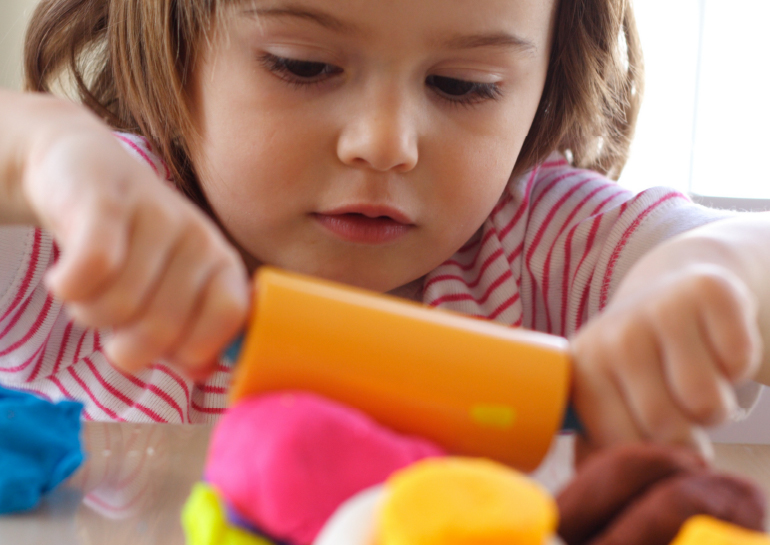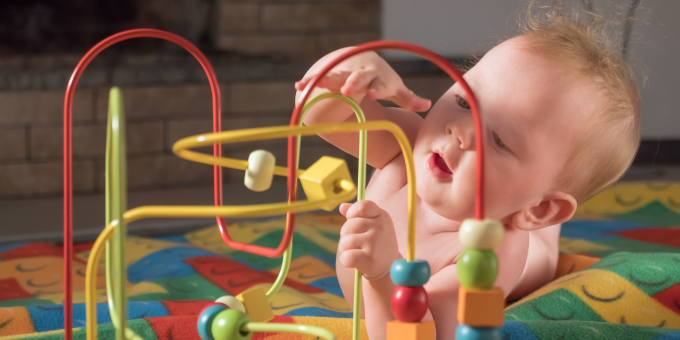
3-year-old Mary kicks up a fuss whenever she is getting her hair cut or nails trimmed.
7-year-old Feng trips easily and has poor balance and uncoordinated movements.
11-year-old Larry runs away or dives under the table whenever he hears sudden or loud noises.
What these children are experiencing could be symptoms of sensory dysfunction known as Sensory Processing Disorder (SPD).
As Sensory Processing Disorder (SPD) is currently not categorised as a medical condition, not many people are aware of this disorder or how to seek proper treatment for it. If not treated, SPD can affect the children and adolescents’ quality of life in various aspects, such as engagement in activities of daily living, performance in school, social behaviour in their communities and interactions with others. These challenges may persist even as they enter adulthood.
One of the most commonly used interventions for sensory processing difficulties is the Sensory Integration approach, which is usually conducted by an Occupational Therapist. Read on to learn what SPD is and how Occupational Therapy can help children with SPD.
What is Sensory Processing Disorder (SPD)?
Sensory Processing Disorder, or Sensory Integration Dysfunction, is a neurological condition in which an individual has difficulty registering, processing and responding appropriately to the stimuli or information received through the senses. The dysfunction happens when the sensory neurons are malfunctioning, which could lead to poor development of skills, emotional regulation and learning performance.
We have 8 different sensory systems that our brain must make sense of to interact appropriately with our environment. These sensory systems comprise the following:
- Visual System (Sight)
- Auditory System (Hearing)
- Tactile System (Touch)
- Olfactory System (Smell)
- Gustatory System (Taste)
- Vestibular System (Sense of motion, head position and spatial orientation)
- Proprioceptive System (Sensations from muscles or joints)
- Interoception (Perception of sensations from inside the body or internal organ functions)
If there is a breakdown in how stimuli are received and processed by the sensory systems, it may result in the child being too overwhelmed, distracted or disengaged. This could greatly disrupt their normal routines and functional independence.
SPD can affect people of all ages, although it is usually identified in children, especially those with developmental delays, developmental disorders or behavioural issues, including those with Autism Spectrum Disorder (ASD).
What are the Causes and Symptoms of SPD in Children?
Oftentimes, children with SPD struggle with important skills and abilities required to achieve success academically and socially. This can cause low self-confidence and esteem, along with other emotional and social issues, which can adversely affect the child’s development and quality of life.
The exact cause of Sensory Processing Disorder is not known, although some researchers have found links of light and sound hypersensitivity to the genes. There are also studies indicating that children who are born premature or who have complications at birth may experience sensory processing issues. Damaged nerves following a brain or spinal cord injury could also lead to SPD.
SPD may affect one or multiple senses. Children with SPD can over-respond or under-respond, depending on the senses that have been affected. The two types of sensory processing disorder are:
- Hypersensitivity, which is over-sensitivity and over-responsiveness to stimuli.
- Hyposensitivity, which is under-sensitivity and under-responsiveness to stimuli.
Some of the common symptoms or signs of SPD could include:
Hypersensitivity
- Heightened sensitivity and overreaction to certain sight, sounds or tastes, e.g. avoid eating certain types of food due to their texture
- Dislike or fear being touched or hugged
- Avoid proximity with others
- Extreme fear of climbing or falling
- Poor balance
Hyposensitivity
- Touch people and objects constantly, even when it is inappropriate
- Unusually high threshold for pain
- Thrill-seeking tendencies
- Clumsiness or uncoordinated movements
- No sense of personal space or boundaries
- Enjoy a movement-based play, e.g. jumping, skipping, etc.
- Fidgety
Most of these children are often anxious and are not able to handle or manage changes well. They may also have frequent tantrums or meltdowns due to their inability to process and respond to sensory stimuli.
Although some of these symptoms may be experienced by children occasionally, symptoms that occur frequently and are severe, such as ones that disrupt or negatively impact day-to-day activities, are red flags and suitable treatment must be sought early.
How Does Occupational Therapy Benefit Children with SPD?
What is Occupational Therapy? According to the Singapore Association of Occupational Therapists (SAOT):
“Occupational therapy is a health profession that focuses on the empowerment and facilitation of people of all ages facing difficulties participating in meaningful activities of everyday living (i.e. occupations). The term “occupation” used in occupational therapy refers to various activities of everyday living that an individual finds meaningful. These activities include and are not limited to self-care, play, leisure, school and work….Occupational therapists will consider the holistic aspect of a person, that is their physical, socio-emotional, and mental/cognitive needs that could impact their recovery process and help them achieve the goals that are most important to them. The work of an occupational therapist may differ depending on the population they work with.
Occupational therapy (for children and youths) focuses on play, school, and social participation functions when it comes to children and young people. Occupational therapy can assist infants, children and young people to play, socialise and learn in their respective environments. Occupations (i.e. meaningful activities) that occupational therapists focus on for this young population may include but are not limited to self-care (wearing clothes, toothbrushing, eating, toileting), school-related activities (handwriting, packing of bags) and leisure participation (playing with friends).”
So, how can Occupational Therapy help children with SPD?
Occupational Therapy (OT) aims to help these children develop appropriate responses to sensations and regulate their sensory input by engaging them in fun and meaningful physical activities. In time, the children will have the ability to generalise these appropriate responses across different settings and situations, allowing them to initiate and participate effectively in their daily activities and interactions.
Occupational Therapists take on the Sensory Integration (SI) approach to treating SPD. The therapists will conduct the sessions in a sensory gym and guide the children through physical activities to allow these children to be exposed to various stimuli in a structured and progressive manner — until their nervous system becomes used to the stimulation and the child is able to process and react to sensations appropriately and more efficiently.
One of the effective methods used by therapists is the DIRFloortime® or simply Floortime, which is a form of play therapy. This therapy is based on a Developmental, Individual Difference and Relationship-based (DIR) model that was developed in the 1980s. The play takes place on the floor with the child, where the therapist follows the child’s lead, imitate the child’s actions by engaging in the activities or playing with the toys that the child is interested in and creates challenges to increase learning. Floortime can help the child develop and hone interpersonal, communication and thinking skills as well as enhance the engagement, communication and interaction between the child and the therapist or parents/caregiver.
You can also learn more about Dynamics On The Floor here. At Dynamics, our Occupational Therapists will first conduct an assessment with the child and interview the parents to identify the child’s strengths, weaknesses and the stimuli they are sensitive to. This will provide us with pertinent information to customise an intervention plan for the child and develop a baseline to monitor the child’s progress. Our Sensory Integration (SI) Therapy is conducted at our modern gyms, The gyms are fully equipped with a variety of suspended equipment, such as swings, ladders, tunnels, therapy balls and more, to provide children with sensory-stimulating and fun therapy.
If you prefer your child’s therapy to be conducted at home or if it is inconvenient for your child to travel to the clinic for therapy, there are Occupational Therapy clinics or therapists who conduct home-based therapy. You can learn more about Dynamics’ Therapy@Home for Occupational Therapy here.
Bonus Tip: How Do You Manage SPD at Home?
We share 5 tips on how you can better manage your child’s SPD at home, and these are best implemented along with professional treatment. These tips are a general guide and should be adjusted to suit your child’s age, condition, needs and learning ability. If your child is seeing an Occupational Therapist, do consult or discuss with the therapist how you can adopt methods that work best for your child.
- Create a safe and conducive environment for your child at home.
For hypersensitive children, they would need a space or place where they can calm down whenever they get frightened or overwhelmed, while for hyposensitive children, this space will be one where they can stimulate their senses without getting hurt or hurting others. For example, you can install comfortable lighting in the space for a child who is sensitive to bright lights, or fill a designated space with cushions for a child who likes to bounce or jump around.
- Plan and implement indoor sensory play and activities.
Sensory activities can help keep your child occupied, let them have plenty of fun, engage them in effective hands-on learning as well as stimulate and develop their senses. Some of these activities include play doughs, finger painting, puzzles and sandboxes. You can get more play ideas here.
- Prepare a bag of comfort items.
Put together items that you know will comfort your child and help them cope with external stimuli (or the lack of it). For example, a comfort pillow, fidget toy, etc. Whether at home or on the go, you can have this bag on hand to help soothe or engage your child.
- Be patient and progress slowly.
Give your child time to ease into new changes. Most of the children with SPD do not cope well with transitions, so when introducing new changes, whether at home or outside, inform your child in advance and take it slow. For example, if you are bringing your child to a new place, do so at a time when there the child is in a good mood or when there are fewer strangers around. Progressing slowly will allow your child sufficient time and space to adjust to new changes, be it places, situations or people.
- Enforce appropriate discipline.
Sensory-seeking behaviours stemmed from a craving for sensory stimulation, while sensory avoiding behaviours are caused by the need to be calmed or soothed from overstimulation. At times, these behaviours can be inappropriate, disruptive or even dangerous. Examples of worrying sensory-seeking behaviours could include the child making loud noises in public places or jumping off the table. Or in cases of sensory avoiding behaviours, the child could be getting agitated in a noisy and crowded place or vomiting whenever they are eating the food they dislike.
It is important to address the wrong behaviour to keep the child safe or to teach the child to refrain from this undesirable behaviour. However, using the usual disciplinary methods would not be effective, and in fact, could be counter-productive, since the child does not understand or know how to manage their condition.
You can first determine if the behaviour is worth the time and attention. If it is something that needs to be dealt with, identify the cause of behaviour or trigger to enable you to redirect your child to an alternative behaviour and explain to them why it is a better alternative.
About Dynamics Success Centre
We are an energetic team of experienced Occupational Therapists who are passionate about helping children and adults lead quality and meaningful lives through Occupational Therapy. We provide inclusive, ethical and quality evidence-based care, and our centre is equipped with modern facilities, which include two sensory integration gyms and a sensory room, along with an extensive collection of educational materials and resources. Therapy sessions are held in a conducive environment, which enables better focus and treatment. We are committed to ensuring that our clients and their family members receive only the best. To facilitate our clients’ development in all areas of adaptive living, we provide integrated support through seamless and hassle-free collaborations with professionals from Dynamics’ in-house multidisciplinary team, such as Speech Therapists, Applied Behaviour Analysis (ABA) Therapists, Educational Therapists, Psychologists and more.




